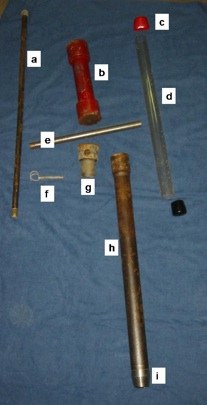
Equipment for acquiring soil core: a) slide hammer rod (screws into drive head), b) slide hammer, c) caps for retaining soil in the plastic liner tube, d) plastic liner tube, e) rod for removing core (slides through hole in drive head), f) pin to attach d
Soil cores are acquired using a steel corer lined with a plastic tube that is pounded into the soil. Several accessories are also necessary (Fig. 1.), and all equipment can be purchased from Giddings Machine Co. (www.soilsample.com). Many researchers use long steel tubes (~ 5 ft. or 150 cm), but we have found shorter 60-cm tubes to be more practical since we work with 45 cm soil cores and since the shorter tubes are more convenient for travel. If longer steel tubes are used, additional plastic liners must be inserted as spacers.
Soil corers may be pounded into the soil using a slide hammer (Fig.1) or with a sledge hammer (Fig. 2). We have found the sledge hammer to be more practical than the slide hammer for use with the 60-cm tubes. Drive heads without holes for the slide hammer rod can be purchased for use with a sledge hammer. Depending on the soil characteristics, pounding in the soil core can be quite difficult and irrigation is recommended, when possible, if working with very dry soils. Rocky soils can also be challenging for acquiring soil cores but it is possible, although usually not worth the effort and equipment damage since few roots are found in cores that are extremely rocky. We recommend having several extra drive heads and bits on hand since these parts are most common to get damaged. Always be sure to screw the bit on tightly to avoid stripping the threads of the corer tube. We usually stop pounding the corer when it is clear that the equipment is hitting a rock.

